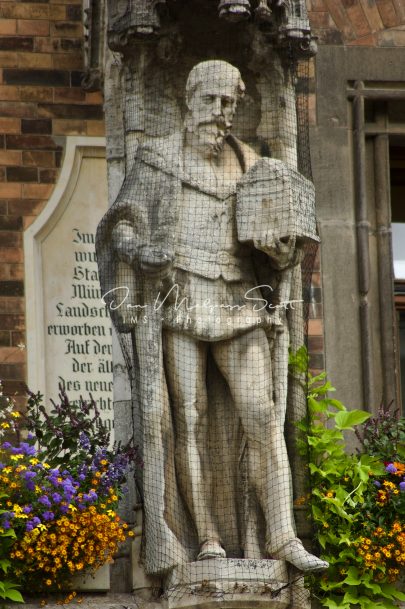![]()
Sculpture on the New Town Hall, Munich
The New Town Hall (German: Neues Rathaus) is a town hall at the northern part of Marienplatz in Munich, Bavaria, Germany. It hosts the city government including the city council, offices of the mayors and a small portion of the administration. In 1874 the municipality had left the Old Town Hall for its new domicile.
History
Inception and construction
The decision to construct a new building came due to the lack of space in the Old Town Hall and the adjoining, so-called “Lesser Town Hall” on Petersbergl (destroyed in 1944, not reconstructed). In memory of the bourgeois high season during the Gothic period, the choice fell upon a neo-Gothic design, which allowed an implement an independent architectural accent in contrast to the buildings of the royal family.
The New Town Hall as it looked like until the extension of 1898–1905
The north side of the Marienplatz was chosen as the building site, where the house of the Landstände still stood which had been erected by the Bavarian Duke throughout the Middle Ages as a sort of representation of the opposing Landstände. The first section of the building in the eastern part of the Marienplatz, on the corner of Dienerstrasse, was the results of an idea competition won by Georg Hauberrisser and carried out between 1867 and 1874. When it became clear that this new building would not be able to accommodate the entire administration, the city began purchasing all the properties on the Dienerstrasse, Landschaftstrasse and Weinstrasse adjacent to the Town Hall started in 1887. From 1889 to 1892, the section on the corner of Dienerstrasse and Landschaftstrasse was constructed.
In 1897, the Magistrate and municipal council decided to extend the buildings on the Marianplatz as well as the Weinstrasse and Landschaftstrasse to create a four-sided complex. For this, the entire area between the Marienplatz and Landschaftstrasse was used and on the other side, between Weinstrasse and Dienerstrasse. In 1898, the work for the extension began with the tower (Rathausturm), also under architect Georg von Hauberrisser. In December 1905, the shell of the third building section was finished with the setting of the keystone on the Rathausturm. For the architectural design of the Munich Rathausturm, Hauberrisser was clearly inspired by Brussels’ Town Hall, whose 96-meter Brabantine Gothic tower was built by Jan van Ruysbroeck in the years 1449 to 1455. By the end of 1906, the offices were handed over. The façade area in the Marienplatz was then 98.5 meters long, of which 48 meters belong to the first construction section. Examples that were used for the design were the Town Hall in Brussels and the City Hall in Vienna.
20th century–present
The minimal damages to the New Town Hall that occurred during the air raids on Munich 1944, were rebuilt after the war. The portion constructed at the Marienplatz received an additional floor, which were hidden behind the neo-Gothic balustrade so that the building’s image was preserved. The façade on the Landschaftstrasse was very simply restored. At the end of the 1990s, the New Town Hall was rebuilt and reconstructed identically, including the neo-Gothic ornaments, which crown the roof.


